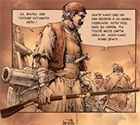thank you guys for your kind words !
Bill, the wagon is a "
carroccio"
here is a google traduction of my two words on it, you can find on the page dedicated to this communal army on my website :
The Carroccio is specific to Italy in the High Middle Ages, and to the way of waging war in the free northern Italian municipalities. A large chariot with four wheels, pulled by oxen, it carried the signs of the city, a large cross, an altar and the martinella, a large bell.
If in times of peace the Carroccio was kept in the main church of the city, at the time of the campaign it left with the army and took part in the fight, protected by elite soldiers. Sometimes, to bring it to the battlefield as quickly as possible, it was dismantled and its parts carried on the back of mules.
Originally, this tank was used by the Lombard arimanni, the free men who fought in northern Italy. Over time, its function became more symbolic and religious, and spread mainly to Lombardy and Tuscany. Its first use as a symbol of Italian communal liberties can also be dated to 1037, when the very powerful Archbishop of Milan Aribert of Intimiamo used it against the troops of Emperor Conrad II the Salicus who were laying siege to the Lombard city. Symbol of the unity of the communes, bringing together noble horsemen and infantrymen-citizens, these tanks were as feared as coveted by the enemy!
The capture of the adversary's
Carroccio was synonymous with a great victory, so when in 1159 the communal troops of Brescia managed to seize the chariot of their adversaries from Cremona, they paraded it triumphantly through the streets of their city before dismantle the bell of the Martinella and install it on the civic tower of the city. During the Battle of Legnano, which saw the united communal forces of the Lombard cities triumph over the Emperor Frederic Barbarossa, it was precisely the resistance of the militias around the carroccio against the imperial knights that offered victory to the Lombard cities against all odds.
This tank of war but not of combat, saw its doctrine of use vary with time. In the 13th century, it was no longer just the army's rallying point, but a weapon intended to "open up" the enemy ranks by being projected there "as fast as a steed". Thus a chronicler of the time could, with a certain sense of exaggeration, write the gesture of the carroccio of the city of Padua (Padova) "which made the whole earth tremble wherever he passed, almost flying like lightning or a dragon " !
Called carochium, carozulum, carrocerum o carrocelum, or even in the Milanese dialect caròcc o caròz, this tank nevertheless fell into disuse in the 14th century with the mutation of the municipal armies into armies of mercenaries, whose attachment to the municipal colors and their symbols were by nature non-existent.










 Supporting Member (Bronze)
Supporting Member (Bronze)





 Moderator
Moderator